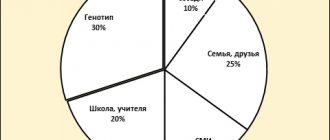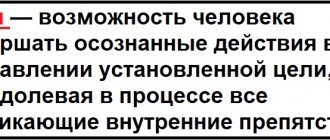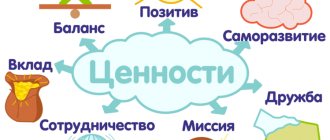13.Definition of attention. Types of attention
The direction and concentration of consciousness on certain objects or certain activities while being distracted from everything else is called
attention.
Attention is the process of conscious or unconscious (semi-conscious) selection of some information coming through the senses and ignoring others.
5 pages, 2020 words
Human perception of information
MINISTRY OF EDUCAMENT AND SCIENCE OF RUSSIA Federal State Budgetary Educational Institution of Higher Professional Education "Russian State Humanitarian University" (RGGU) Branch of RSUH in Balashikha Department of Mathematical and Natural Science Disciplines Abstract on Computer Science Human perception of information 2nd year student of correspondence course of specialty 080504 Shcheglova Yulia ...
Types of attention
Let's consider the main types of attention. These are natural and socially conditioned attention, direct and indirect attention, involuntary and voluntary attention, sensory and intellectual attention.
Natural attention is given to a person from his very birth in the form of an innate ability to selectively respond to certain external or internal stimuli that carry elements of information novelty. The main mechanism that ensures the functioning of such attention is called the orienting reflex. It is associated with the activity of the reticular formation and novelty detector neurons.
Socially conditioned attention develops during life as a result of training and upbringing, and is associated with the volitional regulation of behavior, with a selective, conscious response to objects.
Direct attention is not controlled by anything other than the object to which it is directed and which corresponds to the actual interests and needs of the person.
Indirect attention is regulated using special means, such as gestures, words, pointing signs, and objects.
Involuntary attention is associated with reflexive attitudes. It is established and maintained independently of a person's conscious intention. The properties of the stimuli acting on it, their intensity or novelty, emotional coloring, connection with drives, needs or interests lead to the fact that certain objects, phenomena or persons capture our attention and rivet it for a while to themselves. This is the primary form of attention. It is a direct and involuntary product of interest.
Voluntary attention is distinguished from involuntary attention. The so-called voluntary attention is consciously directed and regulated attention, in which the subject consciously chooses the object to which it is directed. This term serves to designate the fact, central in its significance, that human cognition, like his activity, rises to the level of conscious organization, and does not occur only by gravity, spontaneously, under the power of externally acting forces. The so-called voluntary attention occurs where the object to which attention is directed does not itself attract it. Voluntary attention, therefore, is always indirect in nature.
13 pages, 6332 words
The relationship between voluntary and involuntary memory in preschool children
...as an involuntary process. Involuntary memory occupies a large place in people’s lives and activities: a person remembers and reproduces a lot without special intentions or efforts. Voluntary memory allows a person to remember...remember the color, shape and some other features of the car. Long-term memory is the retention of information in the psyche for a long time. It is believed that …
Involuntary attention is usually presented as passive, voluntary attention as active (James).
The first is directed by factors beyond our control: a sudden noise, a bright color, a feeling of hunger; the second is directed by us ourselves. This second difference, however, is relative: involuntary attention is not pure passivity, and it includes the activity of the subject, just as, on the other hand, voluntary attention is not pure activity; also conditioned by external conditions - the object, it also includes elements of passivity. And finally, the third feature that completes the definition of voluntary attention: it is a volitional operation. Conscious regulation is the most essential in “voluntary” attention.
In distinguishing between voluntary and involuntary attention, there is no need, however, to separate one from the other and outwardly contrast them with each other. There is no doubt that voluntary attention develops from involuntary attention.
On the other hand, voluntary attention turns into involuntary. Involuntary attention is usually due to immediate interest. Voluntary attention is required where there is no such immediate interest, and we, with a conscious effort, direct our attention in accordance with the tasks that confront us, with the goals that we set for ourselves. As the work in which we are engaged and to which we first voluntarily directed our attention acquires immediate interest for us, voluntary attention passes into involuntary attention. Taking into account this transition of involuntary attention to voluntary and voluntary to involuntary is of central importance for the correct theoretical reflection of the real course of attention processes and for the practical correct organization of work, in particular educational work.
In the psychological literature, Titchener noted the transition of voluntary attention to involuntary attention, when, along with “primary” involuntary and “secondary” voluntary attention, he also spoke about the third stage in the development of attention, which marks the transition from voluntary again to involuntary primary attention. This stage is also called post-voluntary attention.
But, according to S.L. According to Rubinstein, it still represents a type of voluntary attention, although no effort is required to maintain attention under these conditions, because it is regulated by a consciously adopted focus on a specific task. It is this - and not the presence of more or less effort - that is the initial, main characteristic of the so-called voluntary attention of a person, as consciously regulated attention.
4 pages, 1744 words
Human memory
... carried out through volitional efforts. Involuntary memory functions automatically, without much effort on the part of the person. Involuntary memorization is not necessarily more... visual, tactile, olfactory, gustatory, auditory memory. Information is remembered in the form of images of a certain modality. Figurative memory is spontaneous, flexible and provides long-term storage...
Finally, we can distinguish between sensory and intellectual attention. The first is primarily associated with emotions and the selective functioning of the senses, and the second with concentration and direction of thought. In sensory attention, the center of consciousness is some sensory impression, and in intellectual attention, the object of interest is thought.
14.Memory. Types of memory.
The processes of remembering, preserving and reproducing a person’s experience are called
memory.
Depending on the activity of storing material, instantaneous, short-term, operational, long-term and genetic memory are distinguished.
Instantaneous (iconic) memory
represents a direct reflection of the image of information perceived by the senses. Its duration is from 0.1 to 0.5 s.
Short-term memory
retains for a short period of time (on average about 20 s.) a generalized image of the perceived information, its most essential elements. The capacity of short-term memory is 5–9 units of information and is determined by the amount of information that a person is able to accurately reproduce after a single presentation. The most important feature of short-term memory is its selectivity. From instant memory, only that information comes into it that corresponds to the current needs and interests of a person and attracts his increased attention. “The average person’s brain,” Edison said, “does not perceive even a thousandth part of what the eye sees.”
RAM
designed to store information for a certain, predetermined period of time necessary to perform some action or operation. The duration of RAM is from several seconds to several days.
Long-term memory
capable of storing information for an almost unlimited period of time, while there is (but not always) the possibility of its repeated reproduction. In practice, the functioning of long-term memory is usually associated with thinking and volitional efforts.
7 pages, 3188 words
Ways, techniques and means of improving human memory.
... specialties and become a professional in your field. This is the ability to use information: a person can apply knowledge only when it is in the head ... mechanisms, or features of one of the types of memory. In experiments, as a rule, there are four variables: 1) variations in the stimulus material and the way it is presented to the subject...
Genetic memory
is determined by the genotype and is passed on from generation to generation. It is obvious that human influence on this type of memory is very limited (if it is possible at all).
Depending on the analyzer that predominates in the process of memory functioning, motor, visual, auditory, {tactile, olfactory, gustatory}, emotional and other types of memory are distinguished.
In humans, visual perception is predominant. For example, we often know a person by sight, although we cannot remember his name. Visual memory is responsible for storing and reproducing visual images.
. It is directly related to a developed imagination: what a person can visually imagine, he, as a rule, more easily remembers and reproduces. The Chinese have a proverb: “It is better to see once than to hear a thousand times.” Dale Carnegie explains this phenomenon by saying that “the nerves leading from the eyes to the brain are twenty-five times thicker than those leading from the ear to the brain.”
Auditory memory
- this is a good memorization and accurate reproduction of various sounds, for example, musical, speech. A special type of speech memory is verbal-logical, which is closely related to word, thought and logic.
Motor memory
represents the memorization and preservation, and, if necessary, reproduction with sufficient accuracy of a variety of complex movements. She participates in the formation of motor skills. A striking example of motor memory is handwritten text reproduction, which, as a rule, involves the automatic writing of once learned characters.
Emotional memory
- this is a memory of experiences. It is involved in all types of memory, but is especially evident in human relationships. The strength of memorizing material is based on emotional memory: what evokes emotions in a person is remembered without much difficulty and for a longer period.
The capabilities of tactile, olfactory, gustatory and other types of memory compared to visual, auditory, motor and emotional memory are very limited; and do not play a special role in a person’s life.
The types of memory discussed above only characterize the sources of initial information and are not stored in memory in its pure form. In the process of memorization (reproduction), information undergoes various changes: sorting, selection, generalization, coding, synthesis, as well as other types of information processing.
According to the nature of the participation of the will in the process of memorizing and reproducing material, memory is divided into voluntary and involuntary
.
In the first case, a person is given a special mnemonic task (memorization, recognition, preservation and reproduction), carried out through volitional efforts. Involuntary memory functions automatically, without much effort on the part of the person. Involuntary memorization is not necessarily weaker than voluntary; in many cases in life it is superior to it.
Introduction
Perception is a process that has long been intensively studied in psychology. This is explained, firstly, by the great practical significance of perception, which stands, as it were, at the beginning of all mental development of the individual. In this regard, the problems of sensory education of a child are raised as the basis for the development of mental processes proper, and the problems of organizing perception, teaching it and the appropriate selection of operators for specific activities in the conditions of modern technology, and problems of visual culture, etc.
The emergence of the first hypotheses about the nature of perception dates back to antiquity. Significant contributions and development of scientific ideas about perception were made by philosophers, physicists, physiologists, and artists. In the second half of the 19th century, ideas about perception became one of the important components of the system of psychological knowledge. In general, early theories of perception corresponded to the provisions of traditional associative psychology. A decisive step in overcoming associationism in the interpretation of perception was made, on the one hand, thanks to the development of I.M. Sechenov’s reflexive concept of the psyche, and on the other hand, thanks to the works of Gestalt psychology, which showed the conditionality of the most important phenomena of perception (such as constancy) by unchanging relationships between the components of the perceptual image.
Currently, the study and development of the process of perception is important, since there is an intensive development of technology and science, and therefore the complexity of perceived objects, the need for a high level of thinking to master new objects, phenomena, etc. Based on this, the theme of the work was chosen as follows: “The influence of thinking on perception.”
The purpose of the work is to consider the relationship between thinking and perception.
To achieve this goal, we have put forward the following tasks:
1. Give a general description of the process of perception, study the types and properties of perception.
2. Study the mechanism of the perception process.
4 pp., 1576 words
DIVERGENT THINKING AS A FACTOR IN THE PERSONALITY DEVELOPMENT OF A SENIOR PRESCHOOL CHILD
Contents Introduction 3 Chapter 1. Psychological and pedagogical features of personality development of a child of senior preschool age 6 1.1. Scientific approaches to the study of the concept of “personality” in psychology 6 1.2. Age characteristics of children of senior preschool age 11 Brief conclusions on the first chapter. 16 Chapter 2. Theoretical approaches to the study of divergent thinking in children of senior preschool age 18 2. ...
3. Identify the relationship between certain types of perception and thinking.
Interaction of perception and memory
The process of human perception of the world around us is not without trace. The images are fixed, saved and reproduced in the future. If a conscious person perceives some objects that he has seen before, then this process is based on recognition. Memory plays a big role in this process.
Finished works on a similar topic
- Course work Integration of mental processes 410 rub.
- Abstract Integration of mental processes 240 rub.
- Test work Integration of mental processes 220 rub.
Get completed work or advice from a specialist on your educational project Find out the cost
If for some reason a person stops remembering or forgets the necessary information received during life, then a disturbance in the perception of the world occurs, the person’s conscious life is disrupted, in fact, life collapses.
Note 1
Perception is inextricably linked to human experience. Experience arises in our minds from memories.
Types of thinking
Under certain conditions or a specific situation, a certain type of thinking is activated. It depends on the tasks and the method of solving them. The following types are distinguished:
- deductive;
- inductive;
- creative;
- analytical;
- critical;
- logical;
- rational.
Using deductive thinking, a solution is found from the general to the specific. The method is often used in scientific research, medicine, and forensics. The use of deduction in professional activities is revealed in detail in the film about the famous detective Sherlock Holmes. His powers of observation, logic and phenomenal memory help solve the most mysterious crimes.
The inductive method is inversely proportional to the deductive method. With this type of thinking, on the contrary, a general conclusion is drawn from several particular situations.
The creative type has the greatest freedom. It is not accessible to everyone, but it can be learned. Most often it is congenital and inherited. Less commonly acquired during life. It is possessed by creative people: artists, sculptors, musicians, cultural figures.
The analytical type is based on a deep analysis of phenomena and situations. It is based on attention to detail and systematization. The conclusion in this case is always based on analysis.
A critical image involves not only analysis, but also building your own chain of judgments. Doubtful facts are necessarily subject to verification to assess their reliability.
The logical type is unthinkable without an intellectual component. It is based on strict rules and laws. This way of thinking once again proves the difference in the mental activity of humans and animals.
The rational method is very similar to the logical method. Serves as a standard term for thinking in psychology. It involves perceiving the world from an intelligent, critical point of view.











